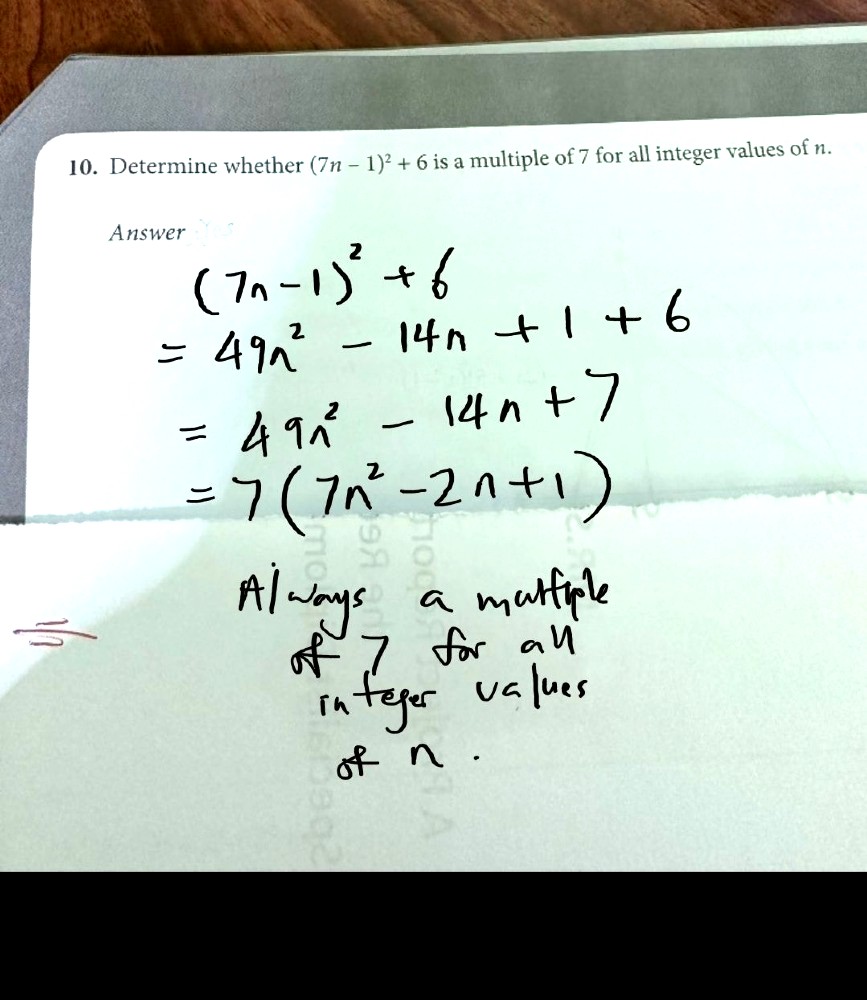Ask Singapore Homework?
Upload a photo of a Singapore homework and someone will email you the solution for free.

See 2 Answers
done
{{ upvoteCount }} Upvotes
clear
{{ downvoteCount * -1 }} Downvotes

Hope this helps. Regards
Date Posted:
1 year ago
Recall the formula (A - B)² = A² - 2AB + B²
(7n - 1)² + 6
= (7n)² - 2(7n)(1) + 1² + 6
= 49n² - 14n + 1 + 6
= 49n² - 14n + 7
= 7(7n² - 2n + 1)
For integer values of n, -2n and 7n² are also integers and so 7n² - 2n + 1 will be an integer.
Since there is a factor 7 outside the bracket, the entire expression should to be a multiple of 7.
(7 multiplied by an integer is still an integer)
One thing to note : If the expression in the brackets can be 0, then the entire term is 0 and so we wouldn't be able to call it a multiple of 7.
We have to further show that (7n² - 2n + 1) is greater than 0 for all integer values of n first.
(7n - 1)² + 6
= (7n)² - 2(7n)(1) + 1² + 6
= 49n² - 14n + 1 + 6
= 49n² - 14n + 7
= 7(7n² - 2n + 1)
For integer values of n, -2n and 7n² are also integers and so 7n² - 2n + 1 will be an integer.
Since there is a factor 7 outside the bracket, the entire expression should to be a multiple of 7.
(7 multiplied by an integer is still an integer)
One thing to note : If the expression in the brackets can be 0, then the entire term is 0 and so we wouldn't be able to call it a multiple of 7.
We have to further show that (7n² - 2n + 1) is greater than 0 for all integer values of n first.
To continue, we complete the square.
7n² - 2n + 1
= 7(n² - 2/7 n + 1/7)
= 7(n² - 2n(1/7) + (1/7)² - (1/7)² + 1/7)
The idea is to rewrite into the form (A² - 2AB + B²) so we can factorise it to (A - B)².
Here your A = n and B = 1/7
= 7( (n - 1/7)² - 1/49 + 1/7)
= 7((n - 1/7)² + 6/49)
Since n is an integer and (n - 1/7)² ≥ 0 for all n,
(Squaring the term makes it non-negative)
Then,
(n - 1/7)² + 6/49 ≥ 6/49 for all n
(n - 1/7)² + 6/49 > 0 for all n
7((n - 1/7)² + 6/49) > 0 for all n
Therefore 7n² - 2n + 1 > 0 for all n
Since we already showed that 7n² - 2n + 1 is an integer, and knowing now that it is > 0 for for n, we can conclude that this term is a positive integer for all integer values of n.
We can now be certain that
(7n - 1)² + 6 = 49n² - 14n + 7 = 7(7n² - 2n + 1)
is definitely a multiple of 7.
7n² - 2n + 1
= 7(n² - 2/7 n + 1/7)
= 7(n² - 2n(1/7) + (1/7)² - (1/7)² + 1/7)
The idea is to rewrite into the form (A² - 2AB + B²) so we can factorise it to (A - B)².
Here your A = n and B = 1/7
= 7( (n - 1/7)² - 1/49 + 1/7)
= 7((n - 1/7)² + 6/49)
Since n is an integer and (n - 1/7)² ≥ 0 for all n,
(Squaring the term makes it non-negative)
Then,
(n - 1/7)² + 6/49 ≥ 6/49 for all n
(n - 1/7)² + 6/49 > 0 for all n
7((n - 1/7)² + 6/49) > 0 for all n
Therefore 7n² - 2n + 1 > 0 for all n
Since we already showed that 7n² - 2n + 1 is an integer, and knowing now that it is > 0 for for n, we can conclude that this term is a positive integer for all integer values of n.
We can now be certain that
(7n - 1)² + 6 = 49n² - 14n + 7 = 7(7n² - 2n + 1)
is definitely a multiple of 7.
Also take note that the term 7n² - 2n + 1 in the brackets cannot be negative as well.
When a number is a multiple of another, we only talk about the positive sense.
Eg.
70 = 7 × 10
70 is a multiple of 7 (it is the tenth multiple)
-35 = 7 × (-5) but we don't say -35 is a multiple of 7.
When a number is a multiple of another, we only talk about the positive sense.
Eg.
70 = 7 × 10
70 is a multiple of 7 (it is the tenth multiple)
-35 = 7 × (-5) but we don't say -35 is a multiple of 7.
Greetings! I believe that zero happens to be a multiple of all integers. My understanding is that negative integers can also be multiples, say for example -70 is a multiple of 7. Regards
Yep you're right in general! But I was thinking along the sense that some syllabuses/tests define the term 'multiple' as positive multiples only, so the working is demonstrated for that context.
Sometimes for factors they also request positive factors only eg. -5 can be said to be a factor of 5 but for some papers like O levels or GMAT that's not accepted.
For competitions like Math Olympiad the term multiples is taken to be counting numbers only (1,2,3,...otherwise known as natural numbers)
Some give the definition of multiple as 'product of two whole numbers' so this would include 0 but not negative integers.
One such reference : MOEMS
https://moems.org › 2022/10PDF
What Every Young Math Olympiad Should Know
https://moems.org/wp-content/uploads/2022/10/What-Every-Young-Mathlete-Should-Know.pdf
Cheers!
Sometimes for factors they also request positive factors only eg. -5 can be said to be a factor of 5 but for some papers like O levels or GMAT that's not accepted.
For competitions like Math Olympiad the term multiples is taken to be counting numbers only (1,2,3,...otherwise known as natural numbers)
Some give the definition of multiple as 'product of two whole numbers' so this would include 0 but not negative integers.
One such reference : MOEMS
https://moems.org › 2022/10PDF
What Every Young Math Olympiad Should Know
https://moems.org/wp-content/uploads/2022/10/What-Every-Young-Mathlete-Should-Know.pdf
Cheers!
Greetings! As far as I know, the Singapore-Cambridge O level papers have not had a question that requires the students to prove that a multiple has to be positive when there is no specification, unless the multiple of interest is restricted by the the function(s) present. I reckon the Singapore-Cambridge O level papers do not seek the students to dwell into the validity and distinction of positive and negative multiples in general, or whether zero cannot be a multiple. The official syllabus does not expound on this matter. Regards
I agree. However like you said, the syllabus doesn't explicitly state the definition of multiple. For students exposed to Olympiad Math, this could be a source of confusion.
I will recommend the student to check with the teachers or department heads just to be sure
Generally I would have left it at 7(7n² - 14n + 1) for my Singapore students taking the local O Levels.
The working above was more of an extra consideration since the student's didn't really mention his/her syllabus (though it is labelled as Sec 3 E Math, there have been occasions where students doing other syllabuses just labelled the closest they could find)
Cheers!
I will recommend the student to check with the teachers or department heads just to be sure
Generally I would have left it at 7(7n² - 14n + 1) for my Singapore students taking the local O Levels.
The working above was more of an extra consideration since the student's didn't really mention his/her syllabus (though it is labelled as Sec 3 E Math, there have been occasions where students doing other syllabuses just labelled the closest they could find)
Cheers!





